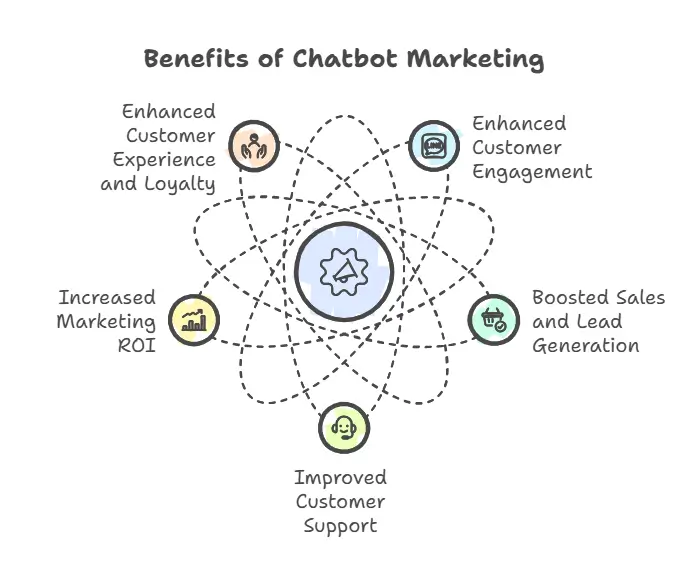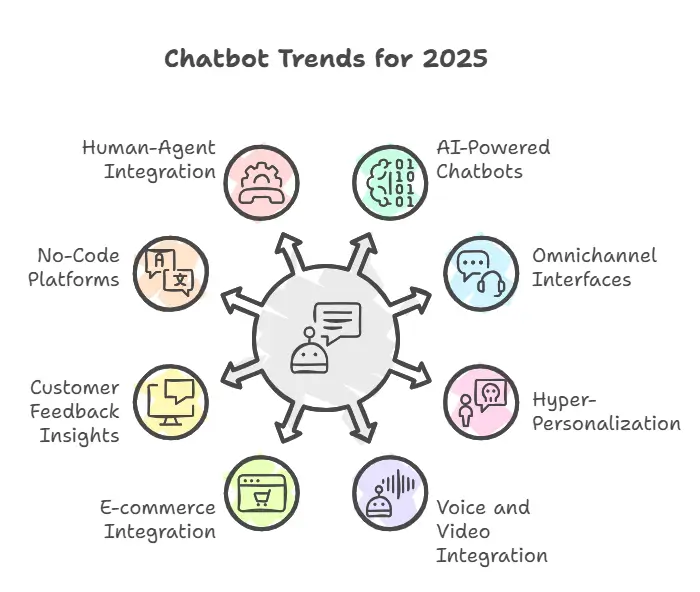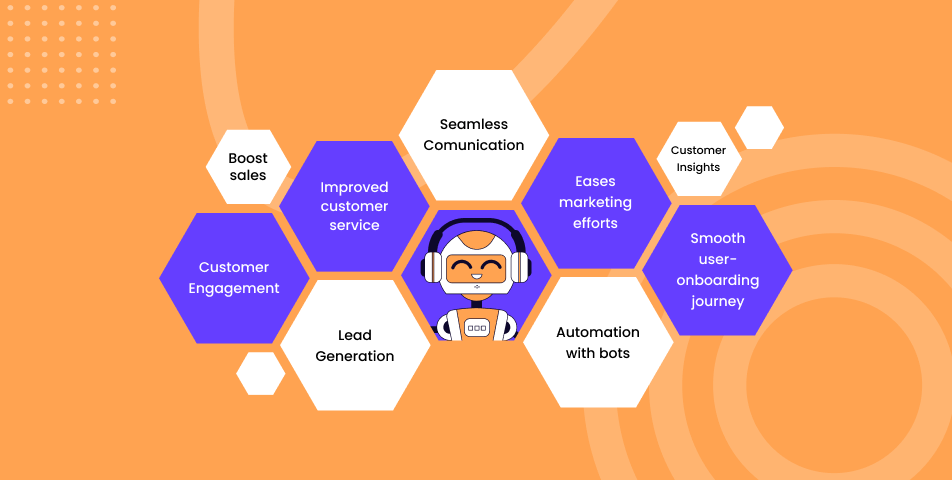Chatbots have transformed how businesses interact with their customers. They simplify processes, provide quick solutions, and offer a personal touch, all while saving time and effort. But how exactly can chatbot marketing boost your business in 2025?
This post dives into the benefits, strategies, and trends shaping chatbot adoption today. From examples of marketing chatbots, like Pizza Hut’s chatbot, to understanding the role of conversational AI and natural language processing, we’ll cover everything. Plus, you’ll learn how businesses like yours can use AI-powered chatbots to improve customer satisfaction, enhance the customer journey, and even boost sales.
If you’re a SaaS company, SMB, or part of a customer support team, this guide is packed with insights tailored for you.
Benefits of Chatbot Marketing

Chatbots are more than just an automated response tool—they’re reshaping the way businesses handle customer interactions and marketing efforts. Let’s break down the key benefits:
1. Enhanced Customer Engagement
Chatbots ensure instant, 24/7 availability on messaging apps like Facebook Messenger, helping businesses stay connected with website visitors and potential customers. Their ability to answer user queries in a timely manner ensures smoother customer journeys, building stronger relationships.
💡 Example: A messenger chatbot for an e-commerce site can guide users through the purchasing journey, answer product-related questions, and recommend items based on customer preferences—all in real time.
2. Boosted Sales and Lead Generation
Chatbots play a vital role in converting website visitors into qualified leads. They can suggest products, provide discounts, and schedule demos, effectively moving users along the sales process. Plus, sales chatbots are instrumental in lead generation by engaging users with marketing messages tailored to their target market.
💡 Example: A chatbot marketing strategy implemented by a SaaS company can engage potential clients during their research phase, offering free trials and collecting their information for follow-ups.
3. Improved Customer Support
AI-powered chatbots with natural language processing are equipped to handle a wide range of customer queries, providing quality service without the need for constant human intervention. For complex tasks, they can seamlessly transfer conversations to a human agent while retaining the chat history for continuity.
💡 Example: A bot marketing system for an online retailer can address common queries about shipping and refunds, escalating only the more complex tasks to a human representative.
4. Increased Marketing ROI
By automating marketing efforts, chatbots reduce costs while driving measurable results. They ensure personalized communication at scale, enabling effective marketing campaigns that resonate with your target market. Chatbots also collect valuable data on customer needs and customer feedback, helping businesses fine-tune their strategies.
5. Enhanced Customer Experience and Loyalty
Chatbots streamline the online shopping experience, ensuring every interaction feels personal. With tools like conversational AI, businesses can engage users with ease, ensuring high customer satisfaction and long-term customer loyalty.
💡 Example: A clothing brand’s chatbot can help users find the right fit, recommend styles, and remember past purchases to create a seamless experience.
Chatbot Marketing Strategies
A solid chatbot marketing strategy ensures businesses leverage these tools to their full potential. Here are the top strategies for using chatbots effectively in 2025:
1. Engage Customers on Messaging Platforms
Popular messaging platforms like Facebook Messenger and WhatsApp are ideal for engaging with potential customers. Using a messenger bot, businesses can send personalized marketing messages, handle user queries, and provide product recommendations. This approach ensures a direct line of communication, which enhances the customer experience.
💡 Pro Tip: Use chatbots to share updates, offer exclusive deals, or answer FAQs on platforms your audience already uses.
2. Personalize the Customer Journey
Chatbots can gather data on customer preferences and behaviors to deliver a tailored purchasing journey. Whether it’s recommending products, scheduling demos, or guiding users to a specific landing page, chatbots help personalize every interaction.
💡 Example: A chatbot for an online bookstore could suggest titles based on past purchases or the user’s browsing history.
3. Support Lead Generation and Qualification
For marketing teams, chatbots are invaluable in capturing qualified leads. They can ask key questions, collect contact information, and even qualify leads by assessing their readiness to buy.
💡 Best Practice: Use chatbots to offer gated content, like whitepapers or webinars, in exchange for user details. This tactic not only generates leads but also provides valuable insights into your target market.
4. Automate Sales and Appointment Scheduling
Chatbots don’t just help with marketing efforts; they play a crucial role in automating the sales process. From guiding users through product catalogs to scheduling appointments for sales calls, they keep the process efficient and hassle-free.
💡 Example: A SaaS company’s chatbot can offer live demos or trial sign-ups, capturing leads and streamlining follow-ups for the sales team.
5. Integrate AI-Powered Chatbots with Marketing Campaigns
Chatbots with machine learning capabilities and conversational AI can analyze user interactions to improve future campaigns. By tracking customer queries, preferences, and behaviors, they help businesses fine-tune their marketing strategy and boost marketing ROI.
💡 Pro Tip: Combine chatbot insights with other tools like email marketing to create unified, data-driven campaigns.
6. Enhance Brand Identity Through Conversational Design
A chatbot isn’t just a computer program; it’s a reflection of your brand. By using conversational tones that match your brand image, you can create a memorable experience that resonates with users.
💡 Example: Many businesses, like Pizza Hut’s chatbot, use fun, friendly language to stand out and engage users effectively.
Chatbot Trends for 2025

As chatbot technology continues to evolve, businesses must stay ahead of emerging trends to maximize their impact. Here are the key chatbot trends expected to shape 2025:
1. AI-Powered Chatbots with Advanced Natural Language Processing (NLP)
Chatbots are becoming smarter with advancements in artificial intelligence and natural language processing. They can now handle more complex tasks, understand user intent better, and provide highly contextual responses. This ensures seamless and human-like customer interactions, reducing the need for human intervention in routine queries.
💡 Example: An AI-powered chatbot can assist customers with troubleshooting technical issues or provide step-by-step guidance for using a product.
2. Conversational Interfaces Across Multiple Channels
In 2025, businesses are adopting chatbots that work seamlessly across various communication channels, such as websites, messaging apps, and even video chat platforms. This omnichannel approach ensures a consistent and connected customer experience.
💡 Pro Tip: Integrate your chatbot across platforms like your website, WhatsApp, and Facebook to maintain continuity in conversations.
3. Hyper-Personalization with Machine Learning
Chatbots are leveraging machine learning to deliver hyper-personalized experiences. By analyzing data like past purchases, customer preferences, and browsing habits, chatbots can anticipate user needs and make relevant suggestions.
💡 Example: A travel chatbot can recommend vacation packages based on previous bookings or user preferences.
4. Voice and Video-Enabled Chatbots
As voice and video interactions gain popularity, chatbots are evolving to include these capabilities. A voice-enabled bot can answer spoken queries, while a video chatbot can demonstrate products or guide users through tutorials.
💡 Example: A fitness app could deploy a video chatbot to provide live workout guidance, enhancing the online shopping experience for fitness equipment or classes.
5. Integration with E-commerce for Seamless Transactions
E-commerce businesses are using chatbots to facilitate in-chat purchases, track orders, and offer personalized deals. Chatbots can also simplify the checkout process, ensuring a smooth purchasing journey for customers.
💡 Example: A chatbot on an e-commerce site can upsell complementary products during the checkout process, driving increased sales.
6. Focus on Customer Feedback and Insights
Businesses are using chatbots not just to serve customers but also to collect valuable customer feedback. By analyzing feedback, companies can identify gaps, improve their quality service, and enhance overall customer satisfaction.
💡 Pro Tip: Use your chatbot to deploy post-purchase surveys or gather opinions on new features or services.
7. No-Code Chatbot Platforms
The rise of no-code solutions means businesses no longer need coding skills to create their own chatbots. This democratization allows small businesses and non-technical teams to build chatbots tailored to their needs.
💡 Example: A local restaurant could quickly build a chatbot to take reservations and answer menu-related questions.
8. Integration with Human Agents for Complex Tasks
While chatbots handle routine queries, the seamless handoff to human agents for more complex tasks remains crucial. This hybrid approach ensures customers receive the best of both automation and human expertise.
Case Studies: Successful Chatbot Marketing Examples
Real-world examples show how businesses leverage chatbots to achieve remarkable results. Here are some standout chatbot marketing case studies:
1. Pizza Hut’s Messenger Chatbot
Pizza Hut introduced a messenger chatbot to simplify ordering and enhance customer convenience.
Strategy Used:
The bot allowed users to place orders, customize pizzas, and check order statuses directly within Facebook Messenger. It also offered promotional deals and menu suggestions based on customer preferences.
Results:
- Significant reduction in order time.
- Boosted customer satisfaction by streamlining the process.
- Increased repeat orders by promoting personalized offers.
2. Sephora’s Virtual Assistant on Messaging Apps
Sephora implemented chatbots on messaging platforms to offer a tailored shopping experience.
Strategy Used:
The chatbot provided beauty tips, product recommendations, and appointment scheduling for in-store consultations. By using natural language processing, it answered customer queries and personalized the customer journey.
Results:
- 11% increase in in-store bookings.
- Higher engagement with the brand, enhancing its brand identity.
3. H&M’s Conversational AI for Style Assistance
H&M launched a chatbot to assist customers with outfit ideas and product discovery on their website and app.
Strategy Used:
By using conversational AI, the bot asked users about their style preferences and suggested outfits or accessories. It also created wishlists and provided details about discounts or promotions.
Results:
- Improved customer engagement with interactive features.
- Boosted sales ROI through tailored recommendations.
4. Amtrak’s “Julie” Virtual Assistant
Amtrak, the U.S. passenger rail service, implemented a chatbot named Julie to assist passengers.
Strategy Used:
Julie used AI to help passengers book tickets, provide travel itineraries, and answer user queries about schedules, pricing, and policies.
Results:
- Saved over $1 million in customer service costs annually.
- Handled more than 5 million customer interactions a year.
- Enhanced customer satisfaction with instant, accurate responses.
5. KLM Royal Dutch Airlines’ Messenger Bot
KLM utilized a messenger chatbot to send flight updates, boarding passes, and booking confirmations.
Strategy Used:
The bot integrated seamlessly with messaging platforms, offering personalized support and answering customer queries in a timely manner.
Results:
- Increased response efficiency by 40%.
- Strengthened customer loyalty with a reliable communication channel.
Conclusion
Chatbots have revolutionized how businesses engage with customers, blending speed, personalization, and efficiency. From automating responses to enhancing customer satisfaction through tailored recommendations, chatbots are no longer just tools—they’re an integral part of the modern marketing strategy.
In 2025, leveraging AI-powered chatbots, embracing trends like natural language processing and no-code platforms, and integrating these tools across communication channels will help businesses stay ahead of the curve. Whether you’re a SaaS company, e-commerce business, or part of a customer service team, the possibilities are endless.
The key to success lies in balancing automation with the human touch, ensuring every customer interaction feels personal and valuable. By investing in the right chatbot strategy, businesses can drive increased sales, enhance the customer journey, and strengthen brand loyalty.
FAQs: Chatbot Marketing
1. What is chatbot marketing, and why is it important?
Chatbot marketing uses chatbots to engage users, deliver marketing messages, and assist with customer inquiries. It’s important because it automates engagement, saves time, and provides a personalized experience that improves customer loyalty and drives sales.
2. How do chatbots improve the customer experience?
Chatbots ensure instant responses to user queries, provide personalized recommendations, and guide users through the purchasing journey. They enhance convenience while maintaining a consistent and engaging tone.
3. What platforms are best for implementing chatbots?
Popular options include messaging apps like Facebook Messenger, WhatsApp, and even websites. Businesses can also integrate chatbots into messaging platforms used by their target market.
4. Are chatbots suitable for small businesses?
Absolutely! With no-code platforms, SMBs can easily create their own chatbot to handle tasks like scheduling appointments, managing inquiries, and generating leads without requiring coding skills.
5. Can chatbots replace human agents?
Chatbots excel at handling routine tasks but may still require human agents for complex tasks or scenarios needing empathy. A hybrid approach is often the most effective solution.


